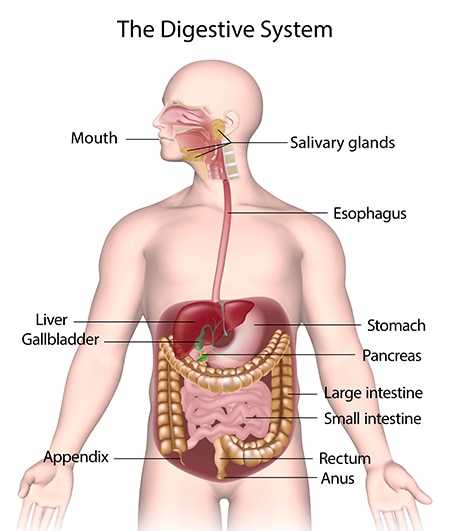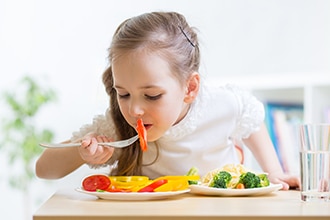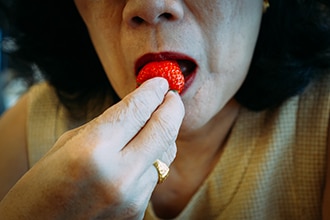When You Blush Your Stomach Also Turns Red How Do They Know
On this page:
- What is the digestive system?
- Why is digestion of import?
- How does my digestive system piece of work?
- How does food move through my GI tract?
- How does my digestive system break food into small parts my body can utilise?
- What happens to the digested nutrient?
- How does my body control the digestive procedure?
- Clinical Trials
What is the digestive organisation?
The digestive organisation is fabricated up of the gastrointestinal tract—also chosen the GI tract or digestive tract—and the liver, pancreas, and gallbladder. The GI tract is a series of hollow organs joined in a long, twisting tube from the mouth to the anus. The hollow organs that brand up the GI tract are the mouth, esophagus, stomach, small intestine, large intestine, and anus. The liver, pancreas, and gallbladder are the solid organs of the digestive organization.
The small intestine has iii parts. The first part is called the duodenum. The jejunum is in the centre and the ileum is at the end. The large intestine includes the appendix, cecum, colon, and rectum. The appendix is a finger-shaped pouch fastened to the cecum. The cecum is the showtime function of the large intestine. The colon is next. The rectum is the cease of the large intestine.

Leaner in your GI tract, also called gut flora or microbiome, help with digestion. Parts of your nervous and circulatory systems likewise help. Working together, fretfulness, hormones, bacteria, blood, and the organs of your digestive system digest the foods and liquids you eat or drink each 24-hour interval.
Why is digestion of import?
Digestion is important considering your body needs nutrients from food and drink to work properly and stay salubrious. Proteins, fats, carbohydrates, vitamins, minerals, and h2o are nutrients. Your digestive system breaks nutrients into parts small enough for your body to blot and use for energy, growth, and cell repair.
- Proteins interruption into amino acids
- Fats break into fatty acids and glycerol
- Carbohydrates break into simple sugars
MyPlate offers ideas and tips to help you run into your individual health needs.

How does my digestive system work?
Each part of your digestive system helps to move food and liquid through your GI tract, break food and liquid into smaller parts, or both. Once foods are broken into modest enough parts, your body can blot and move the nutrients to where they are needed. Your large intestine absorbs water, and the waste product products of digestion become stool. Fretfulness and hormones help control the digestive process.
The digestive process
| Organ | Motion | Digestive Juices Added | Food Particles Broken Down |
|---|---|---|---|
| Oral fissure | Chewing | Saliva | Starches, a type of carbohydrate |
| Esophagus | Peristalsis | None | None |
| Stomach | Upper muscle in breadbasket relaxes to allow nutrient enter, and lower muscle mixes food with digestive juice | Stomach acid and digestive enzymes | Proteins |
| Small-scale intestine | Peristalsis | Small intestine digestive juice | Starches, proteins, and carbohydrates |
| Pancreas | None | Pancreatic juice | Carbohydrates, fats, and proteins |
| Liver | None | Bile | Fats |
| Large intestine | Peristalsis | None | Bacteria in the large intestine can also break down food. |
How does nutrient move through my GI tract?
Food moves through your GI tract by a procedure called peristalsis. The large, hollow organs of your GI tract contain a layer of muscle that enables their walls to move. The movement pushes food and liquid through your GI tract and mixes the contents within each organ. The muscle behind the food contracts and squeezes the food forward, while the muscle in front of the nutrient relaxes to allow the food to motility.

Mouth. Food starts to move through your GI tract when y'all eat. When y'all swallow, your tongue pushes the food into your throat. A small flap of tissue, called the epiglottis, folds over your windpipe to prevent choking and the food passes into your esophagus.
Esophagus. Once yous brainstorm swallowing, the procedure becomes automatic. Your brain signals the muscles of the esophagus and peristalsis begins.
Lower esophageal sphincter. When food reaches the end of your esophagus, a ringlike muscle—chosen the lower esophageal sphincter —relaxes and lets food pass into your stomach. This sphincter usually stays closed to keep what'southward in your tummy from flowing back into your esophagus.
Stomach. Subsequently food enters your stomach, the stomach muscles mix the food and liquid with digestive juices. The stomach slowly empties its contents, called chyme, into your minor intestine.
Small intestine. The muscles of the small intestine mix food with digestive juices from the pancreas, liver, and intestine, and push the mixture forward for farther digestion. The walls of the small intestine blot water and the digested nutrients into your bloodstream. Every bit peristalsis continues, the waste products of the digestive process move into the large intestine.
Large intestine. Waste products from the digestive process include undigested parts of nutrient, fluid, and older cells from the lining of your GI tract. The large intestine absorbs water and changes the waste from liquid into stool. Peristalsis helps movement the stool into your rectum.
Rectum. The lower finish of your big intestine, the rectum, stores stool until it pushes stool out of your anus during a bowel move.
Lookout man this video to see how food moves through your GI tract.
How does my digestive system break nutrient into minor parts my body can utilize?
As nutrient moves through your GI tract, your digestive organs break the food into smaller parts using:
- motion, such as chewing, squeezing, and mixing
- digestive juices, such equally stomach acid, bile, and enzymes
Mouth. The digestive process starts in your mouth when you chew. Your salivary glands make saliva, a digestive juice, which moistens nutrient so it moves more hands through your esophagus into your stomach. Saliva also has an enzyme that begins to break downwards starches in your food.
Esophagus. Afterwards you swallow, peristalsis pushes the food downwardly your esophagus into your stomach.
Stomach. Glands in your stomach lining make breadbasket acid and enzymes that pause downwards nutrient. Muscles of your tummy mix the food with these digestive juices.
Pancreas. Your pancreas makes a digestive juice that has enzymes that pause downwards carbohydrates, fats, and proteins. The pancreas delivers the digestive juice to the small-scale intestine through pocket-sized tubes chosen ducts.
Liver. Your liver makes a digestive juice called bile that helps digest fats and some vitamins. Bile ducts conduct bile from your liver to your gallbladder for storage, or to the small intestine for use.
Gallbladder. Your gallbladder stores bile betwixt meals. When y'all consume, your gallbladder squeezes bile through the bile ducts into your small intestine.
Pocket-size intestine. Your pocket-sized intestine makes digestive juice, which mixes with bile and pancreatic juice to complete the breakup of proteins, carbohydrates, and fats. Bacteria in your small intestine make some of the enzymes you need to digest carbohydrates. Your small-scale intestine moves water from your bloodstream into your GI tract to aid break downwards nutrient. Your small intestine also absorbs water with other nutrients.
Large intestine. In your large intestine, more water moves from your GI tract into your bloodstream. Bacteria in your large intestine help break down remaining nutrients and make vitamin Grand. Waste matter products of digestion, including parts of food that are still besides large, go stool.
What happens to the digested food?
The small intestine absorbs most of the nutrients in your food, and your circulatory organization passes them on to other parts of your body to store or utilise. Special cells assistance absorbed nutrients cross the abdominal lining into your bloodstream. Your blood carries simple sugars, amino acids, glycerol, and some vitamins and salts to the liver. Your liver stores, processes, and delivers nutrients to the rest of your trunk when needed.
The lymph organisation, a network of vessels that carry white claret cells and a fluid called lymph throughout your body to fight infection, absorbs fatty acids and vitamins.
Your trunk uses sugars, amino acids, fat acids, and glycerol to build substances you need for free energy, growth, and cell repair.
How does my trunk control the digestive process?
Your hormones and nerves work together to help control the digestive procedure. Signals menses within your GI tract and back and forth from your GI tract to your brain.
Hormones
Cells lining your stomach and small-scale intestine make and release hormones that command how your digestive system works. These hormones tell your body when to make digestive juices and send signals to your brain that you are hungry or full. Your pancreas too makes hormones that are important to digestion.
Nerves
You lot have nerves that connect your central nervous system—your brain and spinal cord—to your digestive organization and command some digestive functions. For example, when y'all see or smell nutrient, your encephalon sends a signal that causes your salivary glands to "make your mouth h2o" to prepare yous to eat.
You also have an enteric nervous organization (ENS)—nerves within the walls of your GI tract. When nutrient stretches the walls of your GI tract, the nerves of your ENS release many different substances that speed upwardly or delay the movement of food and the production of digestive juices. The nerves send signals to control the actions of your gut muscles to contract and relax to push food through your intestines.
Clinical Trials
The National Plant of Diabetes and Digestive and Kidney Diseases (NIDDK) and other components of the National Institutes of Health (NIH) bear and support research into many diseases and conditions.
What are clinical trials, and are they correct for y'all?
Picket a video of NIDDK Manager Dr. Griffin P. Rodgers explaining the importance of participating in clinical trials.
What clinical trials are open up?
Clinical trials that are currently open and are recruiting tin can be viewed at www.ClinicalTrials.gov.
When You Blush Your Stomach Also Turns Red How Do They Know
Source: https://www.niddk.nih.gov/health-information/digestive-diseases/digestive-system-how-it-works
0 Response to "When You Blush Your Stomach Also Turns Red How Do They Know"
Post a Comment